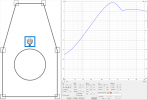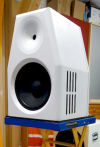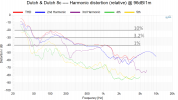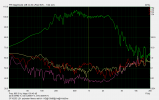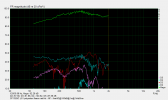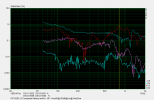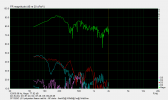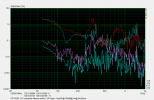Does each cardioid speaker design, using slots, has increased distortion?
If you don't feel like reading the whole text (don't even think about it), the answer is 'no' (and not 42  )
)
I was very intrigued by this question, because if true, sloted design concepts would have a real disadvantage.
In previous posts it was suggested that the main reason for increased distortion in sloted designs (if it happens) is most likely caused by increased driver excursion (and a driver that cannot cope with this excursion, even at low SPL). Because the sloted design for cardioid radiation behaves more or less like an open baffle speaker at low frequencies.
To further support this assumption, a sloted speaker design was created and the distortion behavior of the bass-midrange driver was intensively investigated.
The speaker uses a 10'' midrange driver with very stiff suspension and strong motor (and twin demodulation rings for lower distortion). The strong motor ensures that the damping of the oscillation is mainly electrical and not via the mechanical resistance Rms or by dampening effect of the enclosure - Rms = 5.5 kg/s and Rel = 42.6 kg/s. Therefore, no cabinet with additional damping resistor is needed to control the oscillation behavior of the driver cone - to list a few points why the driver was chosen. With specific OB drivers (low fs, Qts >0.6), Rel is often only half as large, but they provide higher SPL in low bass reproduction in OB speaker concepts.
View attachment 300821
For reference, here again is the harmonic distortion (HD) measurement of the
D&D 8c measured
by Erin.
At 96dB, the speaker reaches at 100Hz almost 10%** HD3 and well over 1%** HD5 (which is really unusual).
View attachment 300825
** unfortunately Erin's HD measurements never show the FR of the fundamental, which makes evaluation and comparability very difficult. The percentages refer to an ideal linear frequency response of the fundamental (which is never the case) - to be able to interpret the HD measurements, one needs the response of the fundamental. Since in case of the 8c the on-axis FR is very linear down to 30Hz, the statement is sufficiently accurate.
The crossover frequency to the subwoofers is 100Hz with fourth order Linkwitz-Riley filter. So at 100Hz the SPL of the 8'' bass-midrange of the D&D 8c is reduced by 6 dB.
If the loudspeaker concept of cardioid radiation via lateral slots and especially the slots themselves (as was also assumed here in the thread) would cause increased distortion, all corresponding speaker designs would have to show this.
Therefore, we now look at the harmonic distortion of the speaker with side slots shown above. I know a 8'' (D&D 8c) to 10'' (speaker above) midwoofer comparison is not fair, but as I said, the point is to determine whether the speaker concept provides for increased distortion.
Measured at 0.3m distance (no gate) with sine sweep at SPL of 100dB@1m@1kHzSine, only the 10'' midrange driver without XO:
View attachment 300885
Down to 180Hz the SPL is at 100dB or above and (T)HD is way below 1% and there is no significant rise of HD (the 8c already shows a few percent THD at 200Hz).
To be absolutely sure, we measure the driver cone and the lateral slots separately in the near field (a few centimeters away) with higher details.
a) speaker 10'' midrange driver near field - first image fundamental with HD, second is HD percentage relative to the fundamental:
View attachment 300887 View attachment 300888
b) speaker lateral slots - first image fundamental with HD, second is HD percentage relative to the fundamental:
View attachment 300889 View attachment 300890
No problems there either, the lateral slots do not cause increased distortions. As expected, the distortion increases with the excursion of the driver at low frequencies.
If the driver quality is good and care is taken to keep the excursion of the driver within its capabilities, then a cardioid speaker design with side slots will not show increased distortion.

